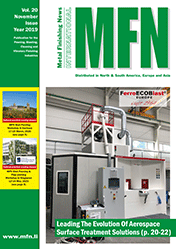E-Archive
Science Update
in Vol. 20 - November Issue - Year 2019
The Adaptation and Reproducibility of The Surface Preparation Standard of Blast-Cleaning by Autonomous Blasting Robot

Figure 1: Transfer Function Model
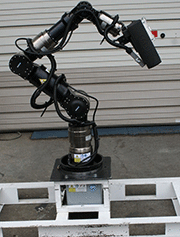
Figure 2: The Autonomous Blasting Robot

Figure 3: Virtual Task Simulation of Flat plate and Conical


Table 1: Blast-Cleaning Parameter
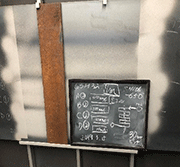
Figure 4: Rust Grade D to Individual Surface Preparation Grade
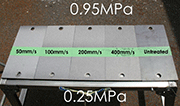
Figure 5: Visual Inspection of Comparing Pressure and Traverse Speed
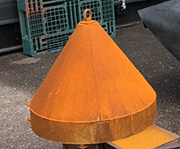
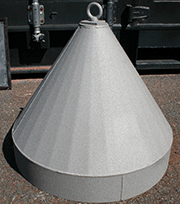
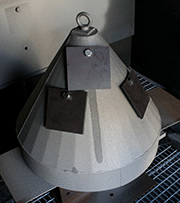
Figure 6: Visual Inspection of Conical
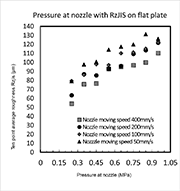
Figure 7: Pressure at Nozzle with Ten-Point Average Roughness Rzjis
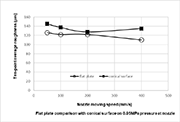
Figure 8: Flat Plate Comparison with Conical Surface on 0.95MPa Pressure at Nozzle

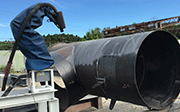

Abstracts
In recent years, demand for accuracy has increased for the blast-cleaning standard. The typical standard is ISO8501-1 or SSPC/NACE. The method of surface preparation by blast-cleaning for old existing bridges, ships, oil storage tanks and various complex structures is mainly planned by the blast-worker, who, in conjunction with the blast-inspector, determines the technique and judgement depending on only visual inspection and their understanding.
As a result, differences occur in the degree of blast-cleaning for each fieldwork site, so a suitable method of using an autonomous blasting robot as one of the most important systems of finding reliable reproducibility and processing history in blast-cleaning has been examined. In the case of autonomous blasting robots, it is possible to automatically plan, simulate, and record such blasting for complex shape information data by cameras and sensors. This is the first report of the method that is managed and reproduced by input of numerical data and calculated algorithm on the autonomous blasting robot.
1. Introduction
This paper is specifically concerned with abrasive blast-cleaning. Recently, there has been rising demand for research interested in the accuracy and reproducibility of the surface preparation grade from all industries using blast-cleaning. The representative of the standard of surface preparation grade is ISO 8501-1, SSPC/NACE SP, which is the abrasive blast-cleaning standard used for various ships and steel structures, although fundamentally, abrasive blast-cleaning is performed by the blast operator and inspected by only visually check by the inspector. As a result, in the strictest sense, the individual work sites reflect various degrees of the surface preparation grade, and in the case of surface preparation defects, an investigator would not be able to identify any such because the processing history of the surface preparation is non-existent, only relying upon the memory of the individual blast-cleaning worker. As a result, after the painting or metalizing, there is no way to follow-up on investigations for surface preparation defects for the process analysis concerning the abrasive blasting condition and status.
On the other hand, if an automated blast-cleaning robot, a programmed blast-cleaning machine or a teaching blast-cleaning robot is used, the machine is only reproducible on the site. This is due to parameters of the conditions including length of distance of the nozzle from target surface, angle, moving speed, track width, abrasive mixing ratio, nozzle type, etc.; all being individual decisions made by the operator. Many companies and research organizations have investigated the parameters regarding specifications for surface preparation as far as blast-cleaning concerns; however, the cause of a surface preparation defect occurrence is sometimes one of the reasons why specifications made do not always follow the same parameters.
Accordingly, the surface preparation defect has been experimented on with the Autonomous Blasting Robot (hereinafter, this is called "ABR") (Figure 1,2). The ABR makes it possible to generate planning tasks and recording histories of blast-cleaning of surface preparation with a video camera and distance sensor for intricately-shaped three-dimensional structures; however, at the present time, the ABR has only a few blast-cleaning installations globally. This is the first report of the abrasive blast-cleaning process, the management process and reproduction for the adaptation and reproducibility of the surface preparation standard grade by the ABR. Ongoing experimentation for various conditions will be performed and should generate a valued database for the future.
2. The purpose of the experiment and requirements
The purpose of the experiment is to perform blasting under conditions of setting parameters for two-dimensional flat steel plate blast-cleaning with the ABR (SABRE Australia). The data is measured with a surface roughness meter in accordance with the standard. Subsequently, reproducibility is considered by comparing it with the data measured in the same way as for blasting treatment for the three-dimensional object by the same parameters. Thus far, blast-cleaning has only been inspected for results, and could not be produced with reproducibility and predictability based on the data. In addition, the simulation and monitoring of the blast-cleaning processes of each part could not be recorded as data, as these are due to the parameters of the blast-cleaning process being recorded according to the experience of the blast-cleaning worker only.
In the future, on the assumption that technologies such as ABR will spread, parameters can be stored and reproduced on a personal computer as a data task. In this experiment, since it was to be adapted to the blast-cleaning standard, data was managed merely using a portable stylus type surface roughness instrument. In this first report, the parameters for the surface preparation grades are numerically input and logged to verify whether there is reproducibility.
3. Experimental Planning
Blast-cleaning parameter is shown in (Table 1). In terms of fixed parameters of the blast-length, blast-angle, blast-nozzle type, blast-track width, the blast-abrasive feed flow rate will be planned to change for the second or third report.
Steel grid was selected since it is one of the most popular grids in the blast-cleaning industry. The electromagnetic field control valve (Peening Accessories GmbH: UltimateValve) is able to accurately control abrasive feed-flow rate. This time, parameters of blast-nozzle traverse speed and blast-pressure at nozzle are given priority. The reason for this is that these parameters markedly affect the blast-cleaning process.
First, to generate the task of blast-cleaning the steel plate 915mm × 915mm × 6mm is set on the simulation mode of the ABR at the set blast-pressure at nozzle and blast-nozzle traverse speed of 50 / 100 / 200 / 400mm/s. Observation of the results of blast-cleaning in which the ARB is used for the task with respect to the steel plate 915mm × 915mm × 6mm is then carried out. The SS400 of the steel plate 150mm × 150mm × 9mm is surface-prepared by blast-cleaning again with the same parameters after fixing on the steel plate 915mm × 915mm × 6mm with a M16 bolt and a nut on the trajectory centre of the blast-cleaning process. The reason for selecting the steel plate of the thickness of 9mm is because the effect of warpage due to residual stress in the surface roughness measurement is small. The surfaces of the 32 steel plates prepared by blast-cleaning were randomly measured at five points per one plate with a surface roughness meter (Mitsutoyo Surf Test SJ-310: λc; 8mm×2, λs; 8μm). The reason for selecting the Rzjis [JIS 2001]: 10-point average roughness is because it is easy to evaluate the surface roughness after the surface is prepared by blast-cleaning. Each parameter was surface-prepared by blast-cleaning for the cone without changing; similarly, after fixing the SS400 of 50mm × 150mm × 9mm to the cone with a bolt nut, the blast-cleaning task was performed by ABR. (Figure 3) Since the purpose of this report is that "Is it possible to adapt to ISO 8501-1 and SSPC/ NACE standards?", the original visual judgment is also delivered as a large amount of photo data for each parameter, but it is not included in this report for convenience.
Finally, a field demonstration verification experiment was conducted.
4. Results and Discussion
According to the results, firstly, it was confirmed that the blast-cleaning higher-up degree of rust removal proportionately lowered the traverse speed of the blast-nozzle. Secondly, rust and mill scale limited and excluded painting or coating, and it was confirmed that the degree of the blast-cleaning standard is not related to the pressure at the blast-nozzle, whereas the number of particles colliding with the surface of the steel grid is related to the degree of blast-cleaning (Figs 4, 5). Thirdly, the difference between 0.25Mpa to 0.95Mpa in pressure at the nozzle is related to the surface roughness as shown (Figure 7). As a result, the confirmation of reproducibility was measured with surface roughness instrumentation, but a minor deviation was observed at 400mm / s, so the value of Rzjis was generally stable (Figures 6, 8).
5. Conclusion
The result demonstrates it is possible to control the degree of the ISO8501-1 or the SSPC/NACE blast-cleaning standard by steel grid collision number per unit area to surface preparation by blast-cleaning with the ABR. Furthermore, it is possible to control the value of the surface roughness (Rzjis) by controlling the nozzle pressure with the ABR. The ABR does not require a second treatment on the same preparation surface, as it can be confirmed that the value of the surface roughness is stable and high. This is a big difference point between the blast-worker and the ABR with respect to reproducibility for the blast-cleaning.
6. Field Demonstration
The contents of this field demonstration are not scientific verifications. Blast-cleaning work is rough work, and field demonstration is important. Can the ABR be replaced by blast workers? A field demonstration attempted to verify that. The ABR and the workers arrived at the blast-cleaning work site to start the test and looked at the object for the first time, being a simple but difficult field demonstration, and because there was no time to program the demonstration object on site. Malfunctions and unexplained outages due to rough conditions related to dust, vibration, and installation in outdoor work sites can easily influence robots. In a typical blast operation, comparing robots with humans, blast-cleaning workers change their standing position, but robots don't change standing position. A typical 6-axis robot for blasting does not recognize its position and the position of the object to be prepared by blast-cleaning, but the ABR recognizes this as shown (Figure 1). However, because the ARB is not able to be moved, a forklift was used and the position of the ABR changed frequently on this field demonstration.
That is to say, it was confirmed that the task was able to be generated in a limited time, evaluating the position via camera and sensor even if the position changed; likewise for the operator without fixing the installation to the ARB as a possible process. The result, preparations and blast-cleaning began at 9:30 am. The field demonstration was accomplished with change for the position and various parameters of the blast nozzle traverse speed and the blast-track width throughout the day, recorded on video, and the work was done by 4:30 p.m. (Figure 9).
7. References
1) Gavin Paul, Stephen Webb, Dikai Liu, Gamini Dissanayake A Robotic System for Steel Bridge Maintenance Field Testing: Center for Autonomous Systems University of Technology, Sydney, 2008.
2) Stephen S. Webb, Belief Driven Autonomous Manipulator Pose Selection for Less Controlled Environments University of New South Wales Australia August, 2008.
3) Prof. Dikai Liu, Prof. Gamini Dissanayake, Dr. Gavin Paul, Dr. Andrew To, A/Prof. Shoudong Huang, Mahdi Hassan, Teng Zhang: An approach for determining appropriate blast parameters (e.g. blasting speed, stream length and stream angle) for re-blasting of those areas/spots: Centre for Autonomous Systems, University of Technology Sydney: September, 2014.
4) Ichiro Atsuchi: The Adaptation and Reproducibility of The Surface Preparation Standard of Abrasive-Blast-Cleaning by The Autonomous Blasting Robot.: The 39th Corrosion Control Technological Conference, Japan Association of Corrosion Control, Tokyo, Japan July, 2019
For Information: Kantou Ascon Co.,LTD. 1747 Ngasuka Kisarazu, Chiba 292-0054, Japan Tel. +81.3.6261-6530 Fax +81.3.3221-6833 E-mail: highblaster@ascon-blast.co.jp www.ascon-blast.co.jp



